您需要知道的 50 个基本设备跟踪技巧
现在,企业比以往任何时候都更有能力有效地跟踪他们的设备,有时只需少量的前期投资。也就是说,目前市场上存在很多竞争,这可能会导致选择困难,特别是在流程、软件和专用跟踪设备方面。幸运的是,互联网上充满了专家资源,有助于将注意力集中在这项令人眼花缭乱的任务上。为了帮助减少脂肪,我们编制了一份包含 50 个设备跟踪技巧的列表,包括组织技巧、流程实施以及维护和维修最佳实践。下面,您将直接从这些专家资源中找到引文,按类别方便地组织。
跳转到:
- 设备的最佳组织策略
- 资产跟踪软件和标签选择最佳实践
- 如何实施设备跟踪计划
- 记录维护和维修
- 如何向员工宣传设备跟踪的重要性
设备的最佳组织策略
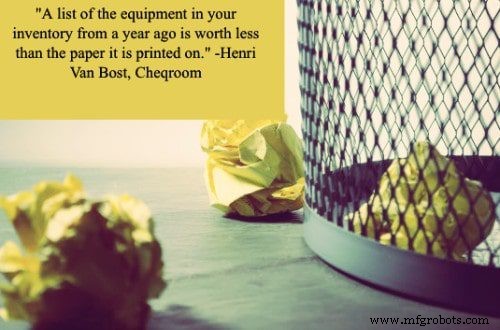
1。在您做任何事情之前,请编制一份最新的设备库存清单。 “你知道你的库存中有什么设备吗?您可能有一个想法,尽管我们相信您所有支持设备的总价值可能高于您的预期。即使你有一个概述,它是一个生物吗?一年前库存中的设备清单价值低于打印它的纸张。” – Henri Van Bost,有效设备库存管理的 8 个技巧 , 衣帽间;推特:@cheqroom
2。超越手动组织设备跟踪。 “人们普遍认为手动库存跟踪方法是一种安全的选择,这正在损害企业。当然,它们价格实惠,并且自里根政府以来就一直存在,但它们也被证明是设备管理的财务和运营责任。” – 跟踪施工工具和设备的终极方法 ,尽快系统;推特:@ASAP_Systems
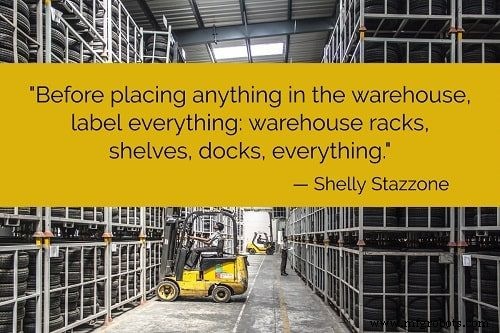
3。整理您的空间,以便可以有效地定位设备。 “在将任何东西放入仓库之前,给所有东西贴上标签:仓库货架、货架、码头,所有东西。仓库标签解决方案专为满足仓库的独特需求而设计,提供定制选项,从远距离反光标签到冷库标签、悬挂式仓库标牌、多层货架标签以及可承受元素。通过选择正确的标签解决方案,您的仓库将更容易导航,拣货和包装将得到简化,组织效率将得到整体提升。” – Shelly Stazzone,如何组织仓库:高效仓库组织的分步指南 , 密码;推特:@Camcode
4。创建设备管理和跟踪流程,帮助您的运营实现目标。 “根据美国交通部的说法,实物资产管理流程的第一步是建立组织政策,包括战略目标和预算。这有助于确定公司未来的需求。第二步涉及收集和分析当前的资产库存和绩效。公司想要达到的目标与今天的目标之间的差异在于公司的战略资产差距,这表明公司需要改进的地方。第三步涉及评估弥合这些差距的替代方案。最后一步涉及持续监控资产绩效并根据需要重新调整资产组合。” – Chirantan Basu,管理有形资产的组织职能 , 计时;推特:@houstonchron
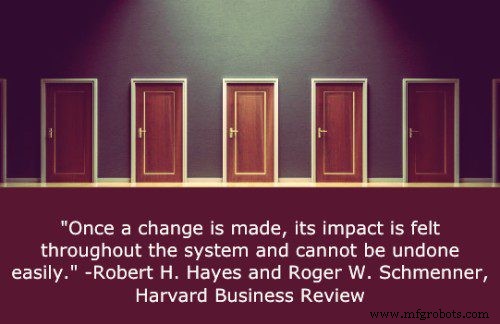
5。做出强有力的组织决策,留下来。 “将一系列制造优先事项转化为适当的工厂、人员和政策集合,需要资源、时间和管理毅力。正如我们之前提到的,大多数公司的大部分资产(资本、人力和管理)都来自制造业。此外,与营销和大多数金融资产相比,这些资产往往是巨大的、高度相关的和长期存在的。因此,很难重定向它们,“微调”几乎是不可能的。一旦做出改变,整个系统都会感受到它的影响,并且无法轻易撤消。” – Robert H. Hayes 和 Roger W. Schmenner,你应该如何组织制造业? , 哈佛商业评论;推特:@HarvardBiz
6。决定一个易于实施和理解的可视化组织流程。 “ 有许多组织工具的现有方法。它可以按工具类型、工作类型(假设可以很容易地进行区分),或者如果您有特别大的选择,甚至可以按字母顺序排列。不同的类别可以存储在不同的区域,便于定位。” – Moira Van Den Akker,管理工具婴儿床库存的简单方法 , 可建造的;推特:@TrimbleMEP
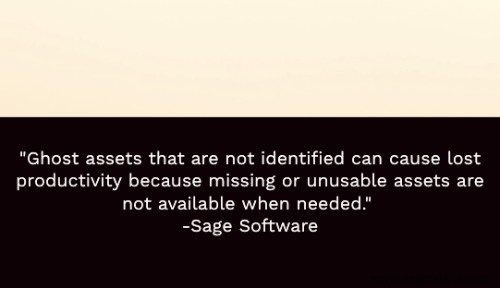
7。识别并消除您的“幽灵资产”。 “‘幽灵’资产是丢失、被盗或无法使用的财产,但仍被列为系统中的活动固定资产……未识别的幽灵资产可能导致生产力损失,因为丢失或无法使用的资产在需要时不可用.资本预算不足,因为管理层不知道需要更换的关键资产。” – 固定资产管理者的最佳实践 ,贤者软件;推特:@SageNAmerica
资产跟踪软件和标签选择最佳实践
8。在选择您的软件之前,首先要考虑您的选择。 “固定资产管理公司可以通过为其组织选择合适的资产跟踪系统来实施最佳实践。为全面控制资产生命周期而考虑的工具包括固定资产会计软件、库存解决方案、自定义报告和项目会计解决方案。在评估软件解决方案时,应特别注意固定资产应用程序之间的集成以及与其他财务解决方案(如总账)的集成,以节省额外的时间并消除数据重新输入错误的可能性。” – 实施包括条形码、扫描在内的固定资产解决方案的好处 ,IT网;推特:@ITWeb
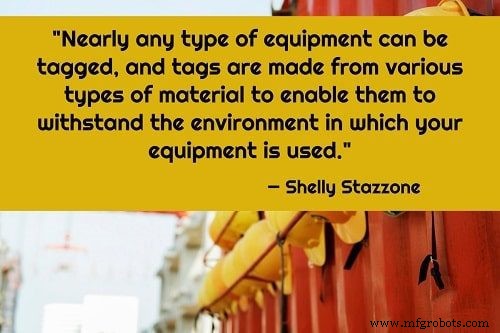
9。确定需要标记以进行跟踪的设备。 “几乎任何类型的设备都可以贴上标签,标签由各种材料制成,使其能够承受使用设备的环境。资产标签通常包含一个条形码,该条形码允许为每件设备分配一个唯一的识别号,以帮助您轻松确定其位置、访问维护计划、确定设备状态等,只需扫描永久性设备标签即可。使用资产标签还可以降低因人为错误或盗窃而丢失设备的风险。” – Shelly Stazzone,设备跟踪最佳实践:资产标签和软件、维护计划等 , 密码;推特:@Camcode
10。考虑您当前的设备跟踪投资。 “选择与现有技术兼容的系统至关重要——例如,有些系统只能在某些设备或操作系统上运行。您需要查看您当前的系统并评估在线订单管理系统是否可以与之集成。” – Jodie Green,如何选择合适的在线库存管理系统 , 灵活化;推特:@fleximize
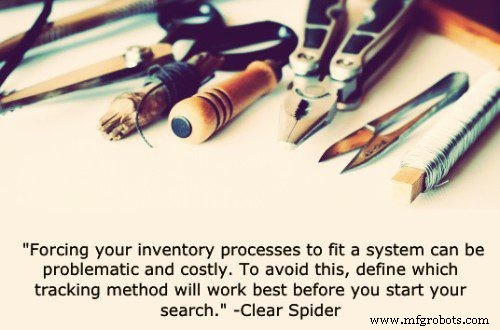
11.确定跟踪资产所需的额外设备。 “有很多不同的方法来跟踪库存,所以知道你将使用哪种方法很重要。您可以使用条形码、序列化、RFID 标签、批次控制和配套来跟踪库存。不仅有许多方法,而且有些方法更适用于特定的库存流程。这就是为什么您应该在开始搜索库存系统之前决定一种方法的原因。并非所有系统都能够使用所有跟踪功能,尤其是在中小型办公市场。强迫您的库存流程适应系统可能会带来问题且成本高昂。为避免这种情况,请在开始搜索之前确定哪种跟踪方法效果最好。
“根据您的选择,您可能需要购买硬件和扫描仪。您要确保您选择的扫描仪可用于您的系统。如果您在系统之后选择扫描仪,它们可能不兼容。或者,兼容的扫描仪可能不适合您的需要。如您所见,在开始搜索之前做出这些决定非常重要。” – 选择正确的库存管理系统的 5 个技巧 ,清除蜘蛛;推特:@clearspider
12.确保您的设备跟踪软件至少包含这些功能。 “……你应该记下你绝对需要的那些,以及你将来可能需要的那些,忘记不相关的功能。还值得注意的是,您的销售点软件可能已经内置了您需要的所有库存管理功能,因此请确保您没有在软件上加倍使用。
- 中央枢纽: 确保您的软件将充当所有购买点(包括在线商店和多个实体店)之间的“中心枢纽”。
- 实时数据: 如果您经营多家商店或管理多个仓库,这一点尤其重要。
- 可用性: 您应该免费试用所有软件,并确保您的员工在购买前能够舒适地使用它。从长远来看,这可以节省大量时间和金钱。
- 安全性: 您的数据应在线备份到云端,而不是存储在本地。
- 技术支持和培训: 您应该询问您的供应商是否包括实施、支持和培训。如果不是这样,这可能是一笔很大的额外费用。
- 硬件集成: 该软件能否与您现有的计算机、操作系统和条码/RFID 扫描仪配合使用?”
– Amanda Layton,PrognoStore 的数字营销专家,选择库存管理软件的终极指南 ,PrognoStore 博客;推特:@PrognoStore
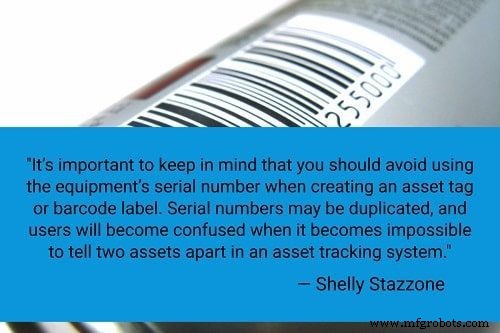
13.为每件设备使用唯一的标识号。 “重要的是要记住,在创建资产标签或条形码标签时应避免使用设备的序列号。序列号可能会重复,当无法在资产跟踪系统中区分两种资产时,用户会感到困惑。解决方案是为每件设备使用唯一的标识号,这样您就没有任何相同的编号。当您选择为您的设备使用唯一标识号时,您将保持数据完整性并实时获得完整、准确的设备信息。” – Shelly Stazzone,设备跟踪最佳实践:资产标签和软件、维护计划等 , 密码;推特:@camcode
14。在购买资产管理系统之前,请索取免费演示。 “检查公司是否提供免费试用或演示。要求它并尝试在相同的条件下进行演示(与您将在组织中使用的相同的硬件和软件配置)。” – Mungara Chinratan,选择正确资产管理软件的 6 条提示,电子学习行业;推特:@elearningindustry
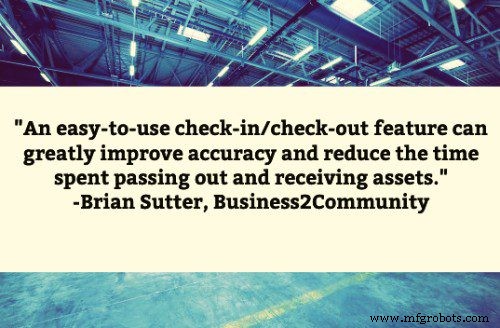
15。寻找简单的入住/退房功能。 “易于使用的签入/签出功能可以大大提高准确性并减少传递和接收资产所花费的时间。寻找具有“快速查找”功能的自动填充字段以进行签入/签出的软件,该功能可按资产标签、资产、供应商、客户或员工搜索您的数据库。一些软件产品允许您在向多个受让人签入/签出多个资产时使用单个事务——这对于工具床、学校和应急响应单位来说是一个很大的好处,这些资产必须定期签入/签出给多个受让人用户。” – Brian Sutter,为您的企业选择资产管理软件时需要注意的 14 件事 , Business2Community;推特:@b2community
16。确定哪些设备需要资产标签。 “回答以下问题可以让您找到一个明确的途径来标记您的资产:
- 哪些工具被盗或放错地方的风险更大?
- 哪些资产使用最多?
- 是否有可能在部门之间移动仪器?
“一旦你列出了所有符合标准的资产,你就可以更好地了解应该标记哪些项目。例如,这可能包括很容易在不同地点丢失的便携式设备或需求量很大的物品。最常被标记的设备包括笔记本电脑、智能手机和打印机。根据企业的规模,这些项目可能是昂贵的资本投资,不易更换。除了货币价值之外,笔记本电脑和硬盘驱动器通常包含机密信息,未经授权的人员不应不惜一切代价访问这些信息。正因为如此,标记任何需要在整个使用过程中受到保护和跟踪的资产变得至关重要。” – 资产标记最佳实践:商业资产标签指南 , EZ 办公室库存;推特:@officeinventory
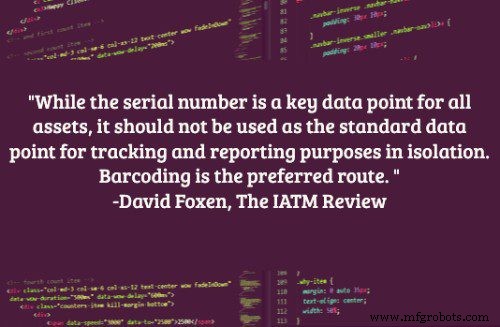
17.如有疑问,请选择条形码。 “在库存过程中,序列号经常重复、损坏或不可用。序列号的格式因制造商而异,不利于数据库密钥标识符。序列号收集容易出现人为错误和解释。序列号通常包含特殊的非字母或非数字字符(#、-、%)。
“虽然序列号是所有资产的关键数据点,但不应将其用作单独跟踪和报告目的的标准数据点。条形码是首选途径。这允许以标准格式为所有资产提供一致的关键标识符。条形码还允许更可控的库存。可以跟踪标签,直观地确认资产,并在库存中捕获。” – David Foxen,硬件资产跟踪快速指南 , ITAM 评论;推特:@itamreview
18.了解对重型设备使用跟踪系统的好处。 “重型设备可以让您知道它什么时候回来,它使用了多少燃料和 什么时候去看医生?更不用说无需喝咖啡就可以为报告做出贡献和进行现场交付?除了减少现在员工在协调和数据收集上花费的时间外,这种“智能”设备还可以帮助管理人员就客户的目标和工作时间表做出决策,这不仅意味着节省时间,还可以获得更多利润。制造商之间的一些专有远程信息处理争论仍在继续,因此目前还不存在对所有设备数据的所有访问权限,但管理人员应该为近期的现场情况做好准备,在这种情况下,很多工作都由以前的‘哑巴’机器完成。” – 高科技设备跟踪如何改变建筑 , 拉肯;推特:@RakenApp
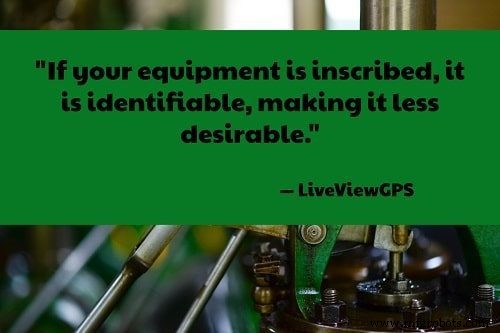
19。使您的设备不易被盗。 “ 将贵公司的名称和地址刻在您的设备和工具上。这样做可以正确识别您的设备,也可以阻止小偷窃取您的设备。如果你的设备被刻上铭文,它是可以识别的,它就不那么受欢迎了。” – 如何打击建筑设备盗窃 ,实时取景GPS;推特:@latracker
20。跟踪修理设备的工具。 “有效的工具跟踪数据会随着时间的推移而积累,管理人员可以确定哪些员工可能需要更多培训或滥用设备。 Prusha 说,工具跟踪是制造业的重中之重,其中特定工具用于修复整个生产线的资产。相比之下,设施经理可能会更频繁地忽视这一过程,因为他们倾向于使用非特定设备,例如割草机、刷子或钻头。对于任何规模的组织,跟踪对日常任务最关键的工具都可以提供更大的监督。” – CMMS 提供商 MAPCON 的高级系统分析师 Brock Prusha 告诉 Taylor Short,使用 CMMS 进行工具管理:优势和最佳实践 , 软件建议;推特:@softwareadvice
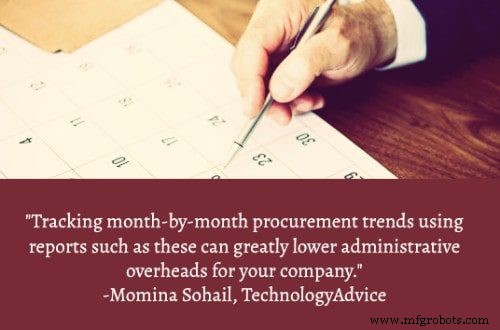
21。运行定期资产利用率报告以进行更集中的跟踪。 “只有通过稳健的资产管理,才能成功执行日常业务运营。为了确保无缝的工作活动,记录资产消耗至关重要。这可以通过生成使用跟踪使用历史记录和签入和签出记录的资产利用率报告来完成。它可以帮助公司设定库存供应阈值,并在需要时轮换设备以延长使用寿命。
“最重要的是,通过利用率报告跟踪消耗可以让您实现采购自动化。这可确保您不会因短缺而面临延误。使用诸如此类的报告跟踪每月的采购趋势可以大大降低贵公司的管理费用。” – Momina Sohail,您应该运行的最重要的资产跟踪报告 , 技术咨询;推特:@Technology_Adv
22。确保您的设备跟踪软件足够灵活,可以进行重要的分类区分。 “你需要能够跟踪你不拥有的东西以及你拥有的东西,并报告比较利用率。这些数据非常有用,可以帮助您决定是否值得为您自己的车队添加额外的物品。” – 资产跟踪软件 – 设备管理最佳实践 ,韦恩;推特:@wynnesystems
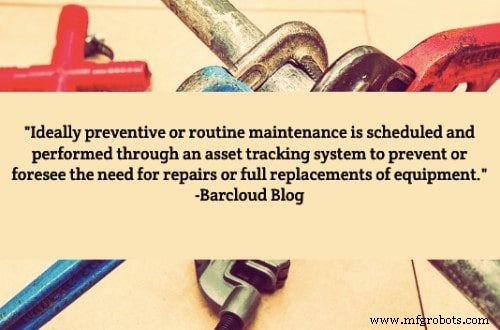
23。增强公司的问责文化。 “资产跟踪为任何公司增加了更高级别的责任感。当管理人员能够详细记录某些资产的使用时间和使用者时,您可以获得可用于解决先前存在的问题的新信息。例如,您可能会了解到您经常丢失仓库 A 中的产品。在调查此事后,您发现每次将新的拾取器发送到该位置时都会丢失一些东西。
“如果没有资产跟踪,您可能从未注意到这种情况正在发生。增加系统的整体问责制也可以防止员工滥用资产。当员工知道他们对资产负责时,他们会更好地照顾他们。” – Dominique Robinson,如何判断您的企业是否需要资产跟踪软件 ,SkuVault;推特:@SkuVault
24。选择基于云的系统进行移动设备跟踪。 “基于云的软件解决方案通过为团队何时以及如何完成工作提供更大的灵活性来补充自动化功能。基于云的平台不是本地或设备上的系统,而是确保团队成员可以随时随地记录和更新数据。此外,云托管系统允许团队实时协作,而不是等待最新版本发出。最后,通过云程序找到更高的准确性,并确保只有一份真实记录。” – 库存管理 101:从简单的库存到基于云的管理 , 智能表;推特:@smartsheet
如何实施设备跟踪计划
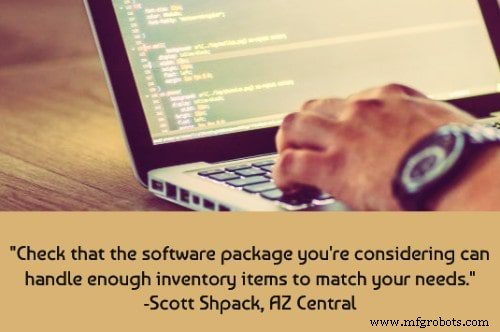
25。通过合并系统从您的设备跟踪中获得更多收益。 “管理库存系统的软件替代方案包括免费软件下载、您自己开发的电子表格解决方案,以及基于云的独立商业库存管理器。您甚至可以拥有专为您的业务设计的定制软件。如果您想将库存软件与会计软件包结合起来,您的选择将会缩小,尽管一些会计软件包内置了基本的库存功能,因此您可能已经拥有库存软件功能。检查您正在考虑的软件包是否可以处理足够的库存项目以满足您的需求。” – Scott Shpak,如何为制造公司实施库存系统 , AZ中央;推特:@azcentral
26。实施后,决定统一单位制。 “计量单位,诸如‘pcs’‘ea’‘lbs’‘bags’等……赋予数量意义,它们属于各自独立的位置,在描述和数字数量字段之外。使用创建良好且一致的计量单位将使库存水平、运输数量和订购数量更容易理解。” - 库存基础 - 库存管理 ,清点库存;推特:@clearinventory
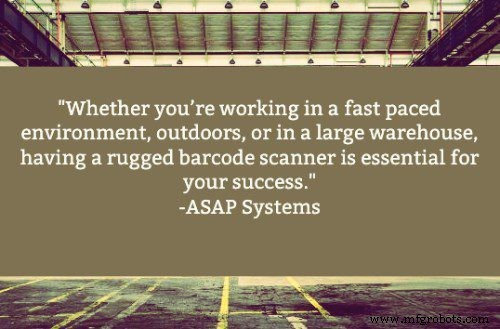
27。选择最适合移动设备的扫描解决方案。 “无论您是在快节奏的环境中、户外还是在大型仓库中工作,拥有坚固耐用的条码扫描器对于您的成功至关重要。标准扫描仪和坚固型扫描仪之间的主要区别在于前者采用完全密封设计,以防止灰尘和湿气。它们还具有防滑手柄,并且通常具有四到六英尺的抗跌落性。” – 库存管理最佳实践 ,尽快系统;推特:@ASAP_Systems
28.为最坏的情况做好准备之前 软件实现。 “备份所有数据并将备份存储在安全的地方。这将是您的紧急信息副本,以防万一出现问题。” – 如何为库存管理软件实施做准备:最大限度地减少中断 ,Zeninventory;推特:@zeninventory
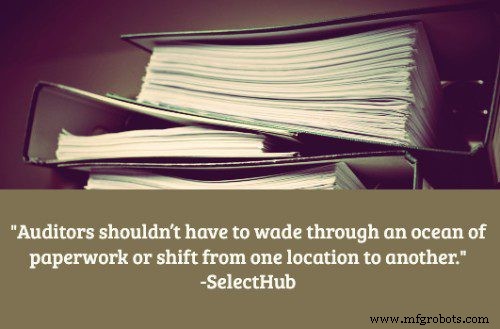
29。将简单的审计选项集成到您的软件集成中。 “审计人员不应该在一大堆文书工作中跋涉或从一个地方转移到另一个地方。借助库存管理系统,他们可以轻松获得所需的所有信息。无论是在电脑上还是在移动设备上,数据都可以在任何地方访问。该软件还应该帮助您保持库存控制”——库存管理系统的来龙去脉 , 选择中心;推特:@SelectHub
记录维护和维修
30。使用您的设备跟踪系统来跟踪维修情况。 “跟踪维修对于识别长期故障设备或滥用操作员至关重要。一个简单的电子表格可能就足够了,尽管专业和复杂的资产跟踪器应用程序可以控制车间的工作、所有权、维护计划、程序升级、库存检查、安装和结构维护。您可以将其设置为资产管理报告,并让部门对其资产负责并控制访问权限。” – 资产追踪 , P25 最佳实践;推特:@TaitRadio
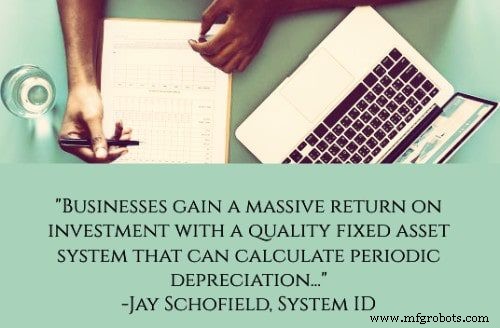
31.使用您的系统制定维护计划。 “Businesses gain a massive return on investment with a quality fixed asset system that can calculate periodic depreciation (using a variety of methods, including straight-line depreciation and double declining balance), identify the need for preventative maintenance in order to extend the fixed asset’s lifespan, and a check-in-and-out process to monitor who had the asset in their possession last, where they had it and for what reason, preventing asset loss due to theft, forgetfulness or incompetence.” – Jay Schofield, What You Need to Know:Fixed Asset or Inventory Management , System ID; Twitter:@systemid
32. Use your equipment tracking tool to follow up on depreciation. “Usually, you don’t report the entire cost of a fixed asset in one year. Instead, you depreciate the expense to account for the asset’s declining value over time. You report portions of the total cost over a fixed number of years. You need to track each fixed asset’s depreciation status to know what to report on your business tax return.” – Amanda Cameron, Fixed Asset Management for Small Business , Patriot Software; Twitter:@patriotsoftware

33. Get clear on the meanings behind different repair cycle strategies. “Ideally preventive or routine maintenance is scheduled and performed through an asset tracking system to prevent or foresee the need for repairs or full replacements of equipment. Alternatively, corrective or emergency maintenance occurs when there is an abrupt need for repair or replacement.
“Maintenance can include, but is not limited to:
- Regularly scheduled inspections of assets
- Making necessary repairs to assets to ensure full functionality
- Replacing equipment that can no longer be used
- Visibility of equipment repair history for accounting purposes”
– Maintaining Maintenance for Asset Tracking , Barcloud Blog; Twitter:@ASAP_Systems
34. Get in the habit of adding equipment utilization data to your general records. “Every firm invests a large amount of capital in its equipment. High-quality tools and machines tend to break down less and function longer. But that doesn’t mean you don’t rigorously monitor their usage. One way to do this is to track when and where your equipment is being used. This can be easily done through equipment maintenance record keeping by tagging all your tools. What this basically does is link your official inventory to an online software. This software is a single access point of information for everyone in your workplace. Every time an employee checks out a machine for use, it is instantly updated in the system. When you know where your tools are, it becomes easier to record their usage history to forecast future trends and patterns.” – What is Equipment Maintenance Record Keeping and How to Optimize It , EZ Office Inventory; Twitter:@officeinventory
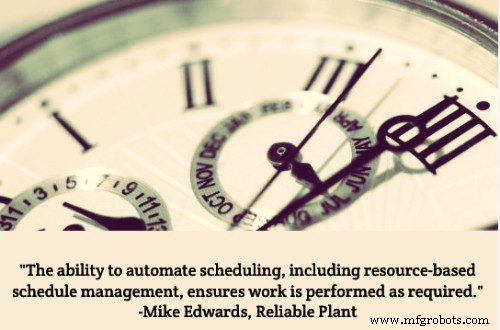
35。 Automate your equipment’s maintenance and servicing schedules. “EAM/CMMS solutions offer more comprehensive maintenance management and recordkeeping, which promotes greater part longevity and is generally required to achieve regulatory compliance. Serialization makes it much easier to monitor and manage maintenance activities and histories, and better solutions support enhanced features such as integration with mobile devices for maintenance activity reporting. The ability to automate scheduling, including resource-based schedule management, ensures work is performed as required.
“In addition, plants gain better control over repair work through their ability to record and analyze repair incidents and intervals. Historical analyses of service and repair records can also help the organization track how specific parts perform in relation to expectations.” – Mike Edwards, founder of AssetOptics, 4 Tips for Better Inventory Management , Reliable Plant; Twitter:@NoriaCorp
36。 Fuse maintenance management into your asset management plan. “While maintenance management and asset management are technically different, they are still interrelated and flow well together. Maintenance management helps to guide the physical performance of maintenance equipment and activities efficiently, while asset management helps to analyze all the data for the work needed to perform on the assets themselves.
“Asset management assists in identifying and prioritizing the work necessary for specific assets not only for the ROI of the asset, but also to analyze and coordinate strategically with work on other opportunities.” – What’s the Difference Between Asset Management and Maintenance Management , Micromain; Twitter:@micromaincorp

37. Always take weather into account when formulating a maintenance schedule. “It’s important to take weather and site conditions into your maintenance plan. Because weather and site conditions change how often and when construction equipment maintenance should be scheduled. In places with acidic soil or salting, it’s important to address this in your maintenance plan. Otherwise important parts of the equipment could end up rusting or corroding and cause unexpected maintenance needs.” – Rachel Novotny, Construction Equipment Maintenance:How Often and When to Schedule , eSUB; Twitter:@eSUBinc
38. Save money by analyzing the key performance data of your equipment. “A major benefit with a maintenance software solution involves data. All the current and historical data related to assets and maintenance is easily accessible in one place.
“’That gives contractors a powerful tool for managing day-to-day maintenance processes, monitoring KPIs, and making strategic ownership decisions like when it is more cost effective to replace an asset versus continuing to maintain it’,” says Kane.” – John Kane, product manager at B2W Software, as quoted by Conexpo Con/Agg, Association of Equipment Manufacturers , Conexpo Con/Agg; Twitter:@conexpoconagg
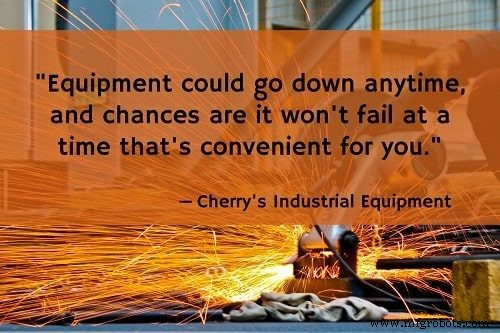
39. Put your equipment on a preventative maintenance track instead of a corrective one. “Equipment failures can shut down part of your plant or even your entire facility. Operations will cease until you can fix the equipment issue. Preventive maintenance helps you catch potential problems before they become major failures, whereas corrective maintenance relies on fixing issues after they’ve already caused disruptions.
“With a PM system in place, you can perform maintenance tasks and fix potential problems on your terms. You can choose to address the issue at a time when you don’t need to use the equipment in question, such as at night, on the weekend or during another time when activity is slow. You can also shut down small parts of your operations one at a time, so your business never has to come to a complete stop. If you rely on corrective maintenance, you have no control over when you perform maintenance activities. Equipment could go down anytime, and chances are it won’t fail at a time that’s convenient for you. These failures will also likely take longer to fix than conducting PM activities would have.” —— The Importance of Preventative Maintenance for Your Material Handling Equipment , Cherry’s Industrial Equipment; Twitter:@CherrysInd180
40。 Learn how to create an equipment downtime report using your equipment tracking software. “You know it’s frustrating to navigate through spreadsheets if your company still relies on manual asset tracking and reporting. Eliminate the need for spreadsheets (with thousands or rows of assets for each location) with a CMMS.
“When you implement a CMMS, you gain real-time visibility and insights that minimize downtime and reduce lost profits. You’ll gain the opportunity to organize all assets in one place in a hierarchical structure, rather than a list for an easy-to-scan downtime report. A CMMS allows you to add equipment to work orders as you populate them. From here, you can sort by overall asset, brand or lifecycle stage, or choose to see asset by location. In one click, you’re able to sort assets or locations by downtime to generate quick, data-driven reports for future decisions.” —— Leah Garcia, How to Create an Equipment Downtime Report in a CMMS , Maintenance Connection; Twitter:@maintconnect
How to Promote the Importance of Equipment Tracking to Employees
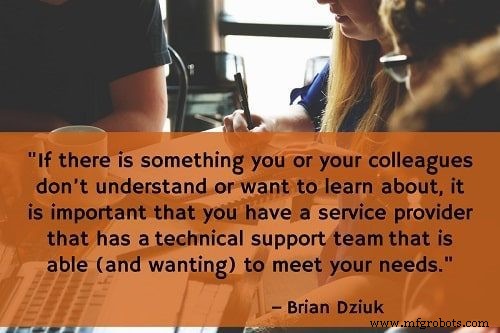
41。 Educate your staff on your new equipment tracking system. “While having a system in place is important, it is just as important that you and your team understand how to use it effectively. Set aside time to familiarize yourself with the software, including its settings, filters, attributes, and understand how to generate reports so you can review important information.
“If there is something you or your colleagues don’t understand or want to learn about, it is important that you have a service provider that has a technical support team that is able (and wanting) to meet your needs. Their team should be able to provide you with useful tips and advice — or point you to a place where you can find those things — to help you get the most out of your system.” —— Brian Dziuk, 4 Tips for Improving Your Equipment Tracking Solutions in 2018 , RasTrac; Twitter:@RasTrac_GPS
42。 Implement strict post-training followups. “Instruction is only part of a successful training regiment. Following up with your staff after their training, while they are using the asset tracking system, can help you ensure that they are using it correctly.
“It’s important for several reasons. First, if there are substantial training-related challenges in using the system, it’s a good opportunity to decide whether additional training is needed. Also, it will help you to determine the effectiveness of the training itself and gives you the opportunity to re-evaluate it and make modifications to the curriculum if necessary. Finally, it lets you conduct performance assessments, and will let you know whether or not the staff responsible for using the asset tracking software are doing so in the most productive and efficient way possible.” —— 5 Tips for Onboarding New Staff with Barcode Asset Tracking Tools , Supply Chain Services; Twitter:@SupplyChainSvcs
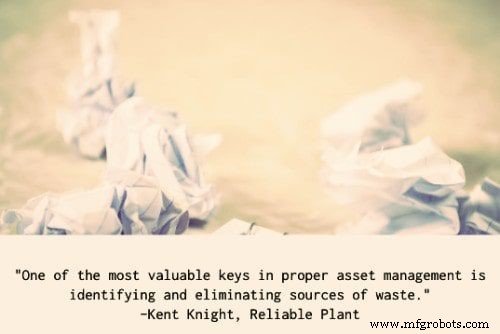
43。 Train your staff to beware of inefficiencies like duplication. “One of the most valuable keys in proper asset management is identifying and eliminating sources of waste. Identify where defects or errors are being introduced into your equipment asset management program. Where can human error influence the quality of decisions made in maintaining assets? With regards to an oil analysis program, sample collection technique, information transcription and information setup can all impact the accuracy of test results.
“Identify where duplication of work is occurring. The use of inefficient, duplicated or overlapping routes to collect predictive maintenance information may result in much time wasted. Entry of information into multiple databases or by multiple people may also be a potential source of error if not administered correctly.” —— Kent Knight, Equipment Asset Management:6 Key Factors for Success , Reliable Plant; Twitter:@NoriaCorp
44。 Put your equipment tracking protocol in writing. “The people who work with your stock and use your inventory system are the most critical element in establishing a pretty good inventory management system. You must make sure that these people know what to do with items that are received, taken from stock, reserved for future use, required for production, or who is responsible for making certain transactions, etc… In some cases this may only be one or two people, but there’s nothing wrong with writing down your policies and making sure they get followed. If you or the people you work with aren’t consistent about the way inventory is handled, it won’t matter what software you use, you will only experience frustration and failure.” —— Inventory Basics – Inventory Management , ClearlyInventory; Twitter:@clearinventory

45. Use equipment tracking to bolster employee accountability. “When trying to shift employee attitudes regarding equipment responsibilities, it always works better to let them know how tracking assets can benefit individual crewmembers as well as the business. For example, explain how GPS tracking can eliminate time-consuming paperwork and provide more accurate data.
“Provide actual examples of how asset tracking directly benefits employees. This can include everything from getting the right vehicles to the job site at the right time to improving driver safety, recovering stolen vehicles and more. It also helps to get employees involved in the implementation and use of asset tracking. When this becomes part of their daily routine, they will naturally take more accountability for the care and proper use of the equipment.” —— Greg Arlen, How Tracking Assets Can Help Improve Employee Accountability , Tenna; Twitter:@Tenna_Co
46. Don’t let employees’ sticky fingers hurt your bottom-line. “Un-reclaimed, unused laptops, smart phones, and software licenses increase IT costs unnecessarily. Aside from new employees taking assets with them, in many organizations poorly tracked assets, including their installed software, simply lie unused in drawers and closets. Even actively used hardware assets often contain software that is paid for but rarely used. These organizations end up purchasing new assets unnecessarily and often pay significant taxes on their unused assets.” —— Automating Employee Asset Lifecycle Management , LANDesk; Twitter:@LANDeskSoftware

47. Provide employees with the trackable equipment they need, starting on day one. “Making sure employees have what they need to do their jobs on day 1 is a critical function of new employee onboarding, yet it’s actually an employee lifecycle process:roles change, new assets must be issued, retired assets must be recovered.” – Employee Onboarding , Assets@Work
48. Ensure that all new employees are added to the updated digital equipment list. “A list should be generated and supplied to an IT asset manager. When assets are returned, a confirmation interface or email should be sent that will trigger the automated process to update the asset management database.” —— Marcel Shaw, Asset Management On-Boarding and Off-Boarding Users , Ivanti Blog; Twitter:@Golvanti
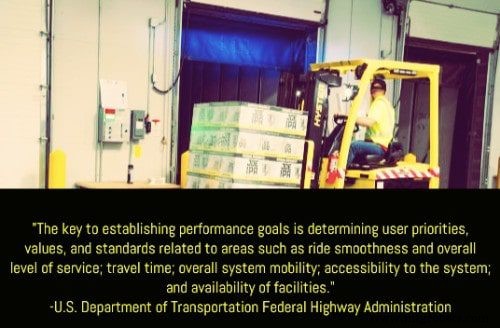
49. Make performance goals known to your employees. “Organizational policies may be thought of as a broad overlay to the process. Nonengineering, noneconomic factors that reflect an agency’s values, perceptions, and predispositions may modify performance-based decisions. For example, established policies, or ‘rules of thumb,’ may direct an agency to select an investment alternative based on historic practice or other reasons. Also, management may assign noneconomic resource constraints to some asset components.
“The key to establishing performance goals is determining user priorities, values, and standards related to areas such as ride smoothness and overall level of service; travel time; overall system mobility; accessibility to the system; and availability of facilities. Goals may be defined in terms of the percentage of assets that meet specified performance levels, as one example.” —— Asset Management Overview:Strategies for Implementation , U.S. Department of Transportation Federal Highway Administration; Twitter:@USDOTFHWA
50. To further tracking optimization, each piece of equipment should have an established ‘owner’. “An owner is normally assigned at an executive or senior-management level within an organization, such as director or vice president. An owner doesn’t legally own the asset assigned to him or her; the owner is ultimately responsible for safeguarding assigned assets and may have fiduciary responsibility or be held personally liable for negligence in protecting these assets under the concept of due care.” —— Lawrence C. Miller, Peter H. Gregory, Determine and Maintain Ownership for Asset Security , Dummies; Twitter:@For Dummies
工业技术


